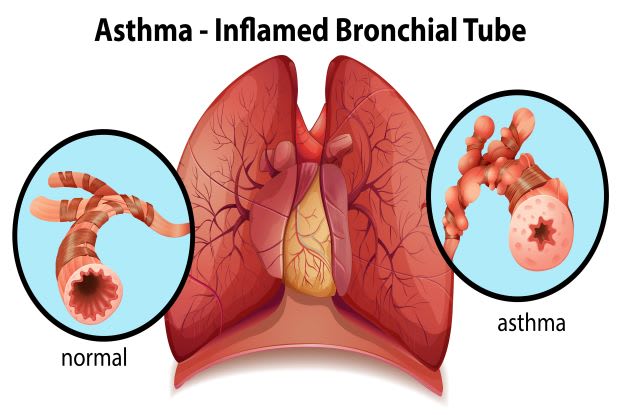Table of Contents
III. Types of Inhalers and their Purpose
Asthma and Inhalers
Asthma is a respiratory condition that can cause symptoms of wheezing, shortness of breath, coughing, and other breathing difficulties. These symptoms occur when the airways are filled with mucus. Excess mucus can cause swelling and narrowing of the airways, restricting breathing.
Asthma patients are commonly prescribed one or more inhalers to relieve and manage symptoms. Inhalers are hand-held devices that administer medication to your lungs. Common asthma inhaler brands include Ventolin, Flovent, and Advair. The right inhaler will give you the best chance of preventing asthma attacks and flare-ups. Read on to learn more about the different types of inhalers available to patients with respiratory illnesses. [1]
Different Inhaler Devices
a. Metered-Dose Inhaler
Metered-dose inhalers are the most common type of inhaler device. They consist of a pressurized canister inside a plastic container and mouthpiece. Medication is released when the canister is pushed into the container. Certain types of metered-dose inhalers do not require a push to deliver the medication. Instead, they automatically release the medication when you inhale.
Most metered-dose inhalers will come with a built-in counter to help you keep track of how many doses are remaining. Newer models often wirelessly communicate with your phone so you can track your remaining doses through an app. For metered dose inhalers that do not have a counter, separate electronic dose counters are available for purchase. [1] Dry-powder inhalers rely on the patient’s inhalation to release medicine into the lungs. When you take a deep breath, the medication from a dry-powder inhaler is pulled out of the dispenser and follows the breath into your airways. When people think of an asthma inhaler, they typically think about a metered-dose inhaler. However, asthma inhalers like the Symbicort Turbuhaler are dry-powder inhalers. [2] Nebulizer inhalers, also known as soft mist inhalers, turn asthma medication into a fine mist and releases it at a low velocity so that it can be gradually inhaled rather than inhaled all in one breath. Nebulizer inhalers are typically larger than metered-dose inhalers. For infants or small children, a nebulizer may be combined with a face mask that fits over the nose and mouth to ensure the right dosage reaches the lungs. Nebulizers can be used by anyone but are particularly used by asthma patients who cannot use a metered-dose inhaler. They are recommended for people who are very ill, young children or infants, and those who require large doses of asthma medication. [1] When it comes to the type of medicine inside your inhaler, there are long-acting and short-acting (emergency) types. For long-term treatment and control over your asthma symptoms, a long-acting bronchodilator may be more suitable. Long-acting bronchodilators can provide roughly 12 hours of relief. Some examples of long-acting bronchodilators include formoterol, salmeterol, and olodaterol. [3] Long-acting bronchodilators can be prescribed to adults and children over the age of five. They make it easier to breathe by relaxing the muscles in and around your airways to keep them open. Long-term treatment of asthma often consists of using a combination inhaler that uses a bronchodilator and a corticosteroid to prevent inflammation and open up the airways simultaneously. [3] A long-term inhaler is designed to reduce respiratory symptoms over time and is not suitable for offering immediate relief during an asthma attack. For emergency flare-up situations, a quick-acting rescue inhaler is required. Emergency inhalers are also bronchodilators, but they work much faster than long-acting types. These medications can relieve acute asthma symptoms within minutes. While long-acting bronchodilators work over a period of around 12 hours, the effects of an emergency inhaler last around two to four hours. [4] If you find yourself relying more and more frequently on your emergency quick-relief inhaler, you may need to see your doctor to adjust your current asthma treatment plan. An increasing reliance on your rescue inhaler may mean your lung health is deteriorating or that you are not responding well to your current long-term asthma medications. Asthma inhalers may also cause side effects like muscle aches, cramps, an upset stomach, or an accelerated heart rate. These side effects are uncommon. Still, you should inform your doctor if your inhaler is causing these side effects. [4] Talk to your healthcare provider to discuss any more questions about inhalers you may have. If you have been recently diagnosed with asthma or have been managing your symptoms for some time, visit Canada Med Pharmacy today to fill your prescription. Asthma attacks can happen suddenly and cause dangerous complications, so always carry your emergency rescue inhaler on your person. The content in this article is intended for informational purposes only. This website does not provide medical advice. In all circumstances, you should always seek the advice of your physician and/or other qualified health professionals(s) for drug, medical condition, or treatment advice. The content provided on this website is not a substitute for professional medical advice, diagnosis, or treatment.
b. Dry-Powder Inhaler
c. Nebulizer

Types of Inhalers and their Purpose
a. Long-Term inhaler
b. Emergency Inhaler

Side Effects of Inhalers
